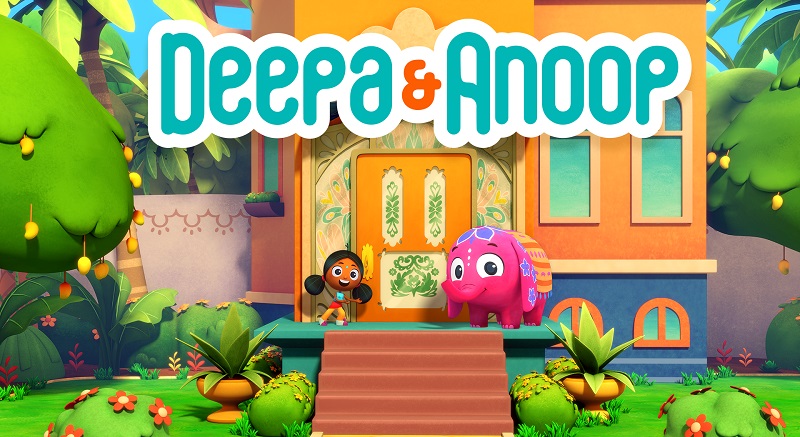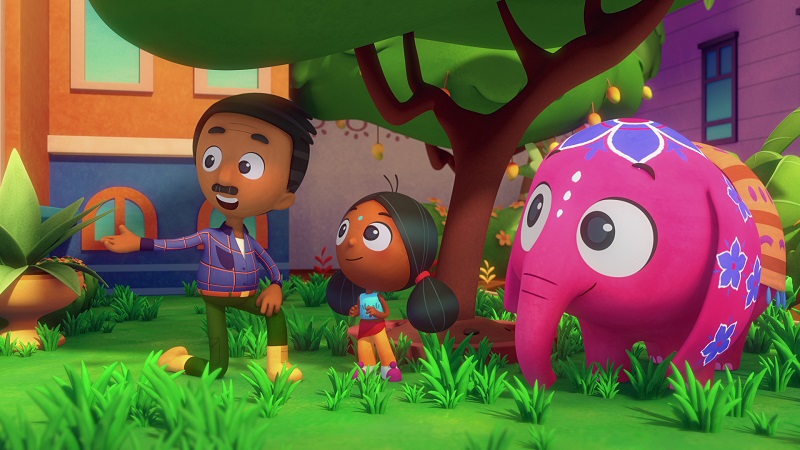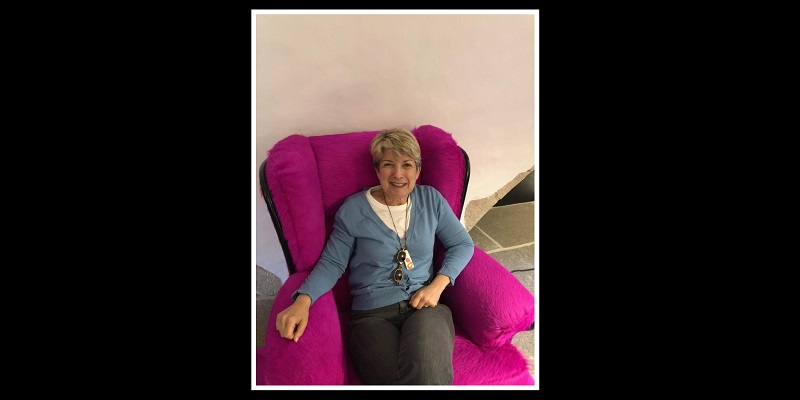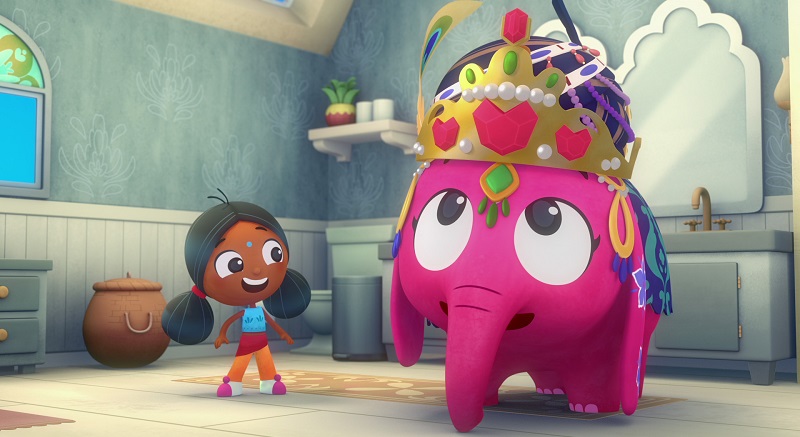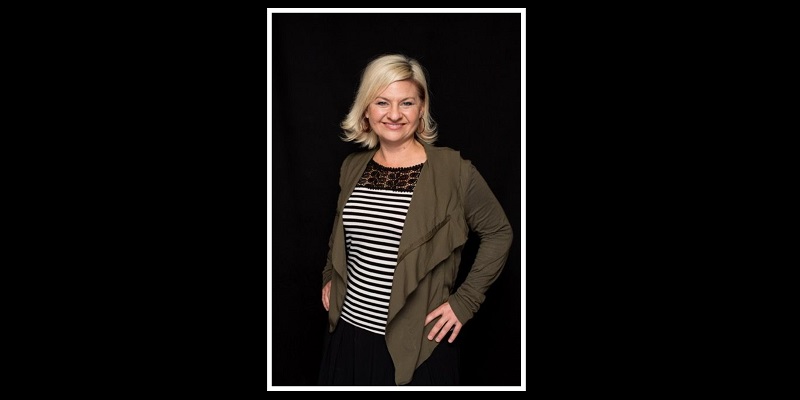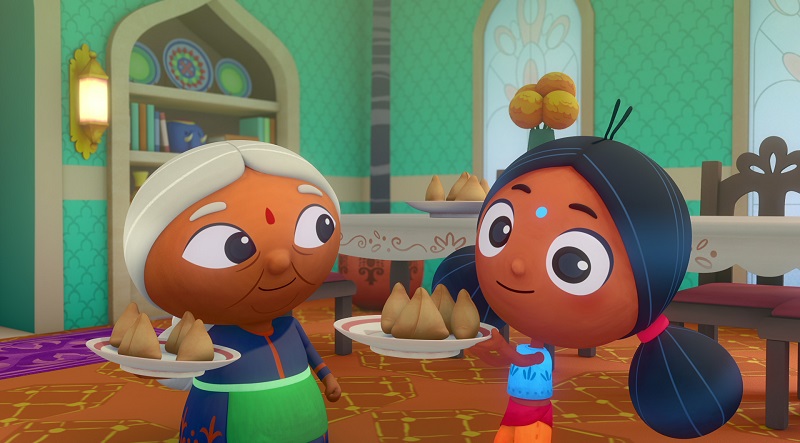Conceptualised more than a decade ago, Netflix’s recent CG-animated series Deepa & Anoop is a celebration of culture that saw the light of the day after years of perseverance and belief. Created by Munjal Shroff, Lisa Goldman and Heather Kenyon, it is Mattel’s first work that is not based on any of their existing properties and is a perfect example of using animation to depict universal messages like friendship while showcasing a country’s cultural beauty. With inputs from Late Ram Mohan who is known as the father of Indian animation, the preschool series is based on adventures of an Indian girl named Deepa who is joined by her colour-changing pet elephant Anoop. The joyful little girl creates music, merriment and mischief at her Indian family’s Mango Manor hotel.
Animation Xpress got in touch with the creators of the show to delve deeper and understand what went behind the making of this IP.
The Netflix Original production was produced by Mattel utilizing the animation test done by Shroff’s Graffiti Studio and, ultimately, KickStart Entertainment and Vsync was hired to do the animation production out of Vancouver and India. The writing, however, was done out of Mattel’s studio in Los Angeles, utilising consultants during every aspect of the creative process. When asked what attracted the toy brand to this show, Mattel Television SVP creative and executive producer Christopher Keenan said, “Its uniqueness.”
“When I first heard the pitch for Deepa & Anoop eight years ago, I was immediately struck by the richness of its cultural roots, its dedication to introducing under-represented characters to a global audience, and the sheer passion of the project’s creators. It was the very first original property that I optioned back then as I took up the mantle as the head of creative for Mattel’s HIT Entertainment,” Keenan exclaimed.
Interestingly, Deepa & Anoop is a befitting example of how an original idea can become a global love with a genuine collaborative approach. Global audiences have embraced the characters as the series’ themes and stories are relatable to all children, regardless of region, nation, or ethnicity.
“One of the things I hear most consistently from viewers is how much they adore the look and feel of this unique series as well as the incredible score and musical numbers that have been conceived in the tradition of India’s best Bollywood musicals,” he said.
The ideation process
The seed of this show was planted back in 2006 when veteran animation writer Goldman met Kartik Mohan (son of Ram Mohan) during his visit to a Women In Animation (WIA) NYC meeting, when she was the president of WIA in 2006.
Recalling her association with Ram Mohan, she said, “Shortly after I met Kartik, he said he wanted me to meet his parents who were visiting from India. I said yes and little did I know Kartik’s dad was the Walt Disney of India. Ram Mohan changed my life! Truly! We had many discussions and in one, Ram told me how India would never be a leader in the industry until India was creating its own IP. His company, Graphiti Multimedia, was starting an animation school at the time and he wanted me to teach a workshop on writing for animation/creating shows. I instantly said yes! And this is how a nice Jewish girl from Nutley, New Jersey winds up with an animated Bollywood preschool show.”
Goldman attended Mumbai International Film Festival (MIFF) as she was chosen to be on the international jury that time. While she was here, it was her first exposure to India and Bollywood. Before coming to India, the lady who was aware of Bollywood films like Monsoon Wedding, Bride and Prejudice, Bend It Like Beckham and actor Shah Rukh Khan, was quite fascinated by Page 3 articles of a leading daily. At that time, creators started toying with the idea of taking Bollywood as their inspiration.
“Originally, Deepa was called Dimple. Munjal and I always had a lot of fun working together. We learned a lot. Sometimes people share in a project but when 17 years happen, you share a lifetime. It’s been great knowing Munjal and working with him all these years. It’s rare that you get this kind of opportunity. And it was an honor to know Ram Mohan,” she said.
Talking about the ideation to final output process, Shroff intricately explained, “The original idea was having an Indian family and their grandparents are ex-Bollywood stars who are now settled in the US and are running a Bollywood dance studio. We were very clear about wanting something around India and Bollywood. Bollywood song and dance is something we were sure that kids would love. We liked the idea and Ram Mohan sir, Lisa, and I started developing it,” he said.
Ram Mohan was also initially involved and interestingly some of the initial sketches of Deepa were done by the maestro himself. But he always allowed his mentees to have their own voice.
While brainstorming to create something unique, the creators decided to star a dog along with the female protagonist which was later changed to elephant as it resonates with India and had never been done before. The creators wanted to showcase the characters’ interaction with one another and that’s when the fascinating concept of showcasing Anoop’s emotions via colors came into place.
Asked about elements that will make Deepa and Anoop memorable, Goldman said, “It’s their friendship that has no limitations and it’s all about love. It doesn’t matter that Anoop doesn’t speak. They understand each other perfectly. They each can’t do it alone, so it’s a perfect partnership of fun, comical, love, kindness, support and understanding. Also, they are surrounded by a very loving and supportive family and friends. The animals in the house are also a part of the family.”
Keenan highlighted, “There are so many aspects of Deepa & Anoop that I would describe as “special,” but central to the concept’s DNA is the notion of “inclusion.” Deepa’s multigenerational family runs a small inn and plays host to guests of every kind. With this diverse roster of visiting guests, Deepa and Anoop are regularly challenged to accommodate guests’ specific needs, preferences, and sensibilities and it’s our stars’ efforts that make this show particularly special: Everyone is not only welcome; everyone matters.”
Writing for Animation
Asked about the difference between working with Indian writers and those overseas, Shroff said, “The overseas writers are a lot better at crafting the screenplay. They understand how to write for animation. Very few writers in India truly know that. The best part about all the people who have worked with us on Deepa & Anoop is that they are extremely good in writing for the animation medium. The process of taking the feedback and working on it was managed very well by Mattel.”
Writing for this sector is indeed a niche field which requires a lot of understanding of the medium.
“It’s super fun to write for animation because it’s a medium where gravity does not apply-if that’s what you want. It’s a medium you can push and the only limits are your imagination and/or budgets. Whatever you do however, needs to work organically with your show. As a writer in animation, you are also the set and costume designer…you write in all the details which you don’t do in live-action,” Goldman commented.
Developing the beloved characters
Shroff’s inspiration for Anoop came from the Jaipur Elephant Festival and the Kerala Elephant Festival. He wanted to show the vibrant, lively, artistic India. He was exposed to a lot of Indian diversity when he was working on Krish, Trish and Baltiboy and folk stories based movies series and felt that it needs to be conveyed. Apart from the elephant, there is Bina (the macaw), Maruti (the monkey) and Munjal (the tiger). These characters came in when they started working with Mattel.
What they have done with the look is that although everything is in 3D, they have gone with the painted, textured and grainy feel, which gives it a slight 2D look as well.
Speaking of the message that he tried to convey through his show, Shroff has to say, “The love in the family.” A lot of elements seen in the show are something that has come out of personal childhood experiences of Shroff especially the relationship of Deepa with her nani-ji and mother. Also, how the guests are treated as if they are a part of the family, how they go out of their way to make them feel comfortable are all part of Indian culture symbolising the concept of Atithi Devo Bhava meaning the Guest is like God.. “Looking back now, as a creator, I am now realising how my experiences have shaped this show. So we have put personal elements consciously or subconsciously and that is what makes it unique.”
Forming the right partnerships
In around 2012, Shroff and Goldman started pitching their idea and they received interest from the BBC, Cartoon Network US, Cartoon Network UK, Cartoon Network Latang, Cartoon Network Italy and so on. All major broadcasters whom they met loved their idea, but due to internal shuffling in these companies, the project did not get a start.
At this point Shroff realised the need of someone’s help. Eventually in 2014, former editor-in-chief of Animation World Network Kenyon, who had worked in Cartoon Network and knew project development and finance, came on board. Shroff and Goldman had prior association with Kenyon.
Kenyon said, “Just like Christopher I could see the passion for this project that Lisa and Munjal had. They just loved this character. Plus, at the very end of the bible was the most adorable piece of art that Munjal had done — it was Deepa with a parasol, riding Anoop away from camera, and she’s looking over her shoulder smiling. I got to the end of the pitch, saw that final piece of art and was like, “I’m in!” It was special, different, unique but also grounded in very universal themes — a lively little girl wanting to help her big, fun family. So you had a universal appeal, a universal story, wrapped in a world that people would either be eager to see as they saw themselves or would want to watch to see these new sights, hear this maybe new sounding music and want to try whatever it is that Naani-ji is cooking up in the kitchen. I admit — I eat more ladoos now since watching this show.”
Talking about the association, Keenan said, “Heather Kenyon is the person who introduced me to Lisa and, in turn, Munjal. She set up a meeting at MIPCOM for me to meet Lisa and hear a pitch for a different project (on which I passed) and, when I asked if she and Lisa were working on anything else, they shared the early development for Deepa & Anoop (then entitled ‘Dimple’). It was ‘love at first pitch’ and I made an offer that day… I then met Munjal through Heather and Lisa and we’ve been collaborating ever since! Heather is truly the link between us all.”
OTT release for Deepa & Anoop
With the passage of time Deepa & Anoop that was liked by big broadcasters was ultimately taken up by the OTT giant Netflix.
“Netflix was the very first place that Heather Kenyon and I took Deepa & Anoop as we felt strongly that it would be the perfect home for this globally appealing show,” Keenan revealed.
According to him, from day one, Netflix has been incredibly enthusiastic about the project and has supported it through thick and thin. When the decision was made that Deepa & Anoop would be a Netflix Original, it demonstrated Netflix’s commitment to finally bringing these beloved characters to life.
Regarding the show’s Netflix release, Kenyon said, “Across the board, Netflix has served up such a variety of programming from all over the world. Prior to Netflix, most folks in the US weren’t watching German comedies and thrillers, Scandinavian post-apocalyptic sagas, Spanish robbery thrillers and so many documentaries. Netflix has really brought world programming into everyone’s living rooms. And I think it is a result of starting as a platform where as long as you had a subscription — you could log on and search and find great, diverse content.
It wasn’t a platform that grew out of a specific territory keeping only that territory’s audience in mind. Deepa and Anoop can be enjoyed by any preschooler but I hope Netflix and Mattel saw the potential — as I did — of being able to offer something special that really spoke specifically to South Asian kids and kids who have South Asian heritage. Not only is India such a huge and burgeoning country but the diasporas of South Asians around the world really makes Netflix a perfect fit. You can be in India or the UK, the US, Canada, Germany — and hopefully see a little of your grandma in Naani-ji.”
The way ahead
The newly launched show has immense potential. The creators are optimistic about growing the IP in various directions.
“Deepa and Anoop are such a great duo! They have so many more stories to tell and we feel they can do so in more episodes, longer movies, stage plays, books, etc. We feel the property can grow in so many directions because the work has been put into who these characters are, what their world is, etc. by the team,” Kenyon shared.
Having full faith in her creation and the amazing response, Goldman said, “I see the show going for many seasons. As done with Dora, I think Deepa and Anoop also have the potential to grow up. I see movies…there needs to be a Bollywood movie, right?! It would be cool to even see a live action version of the show. I think anything is possible. And since I live in New York city, I would love to see Deepa & Anoop balloons in the Macy’s Thanksgiving Day Parade. Seriously, I just hope kids and their families enjoy the show.”
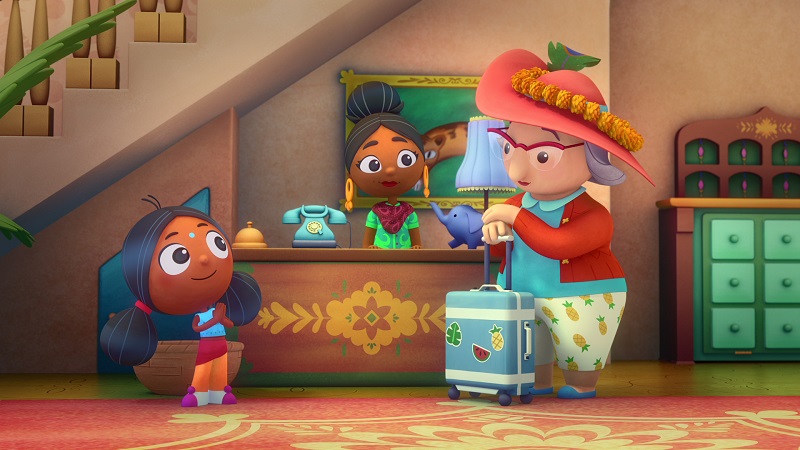
Shroff would love to see organically how the show does. He is rooting for a Broadway musical as the show has all the components for it.
Keenan did not reveal much about their plan for Deepa & Anoop. However, he did disclose that Netflix will be dropping a second batch of Deepa & Anoop episodes this year (dates by region still TBA).
Well, we can’t wait to see more of Deepa & Anoop not just on Netflix, but also in the hands of kids in the form of toys, merchandise, and much more!

